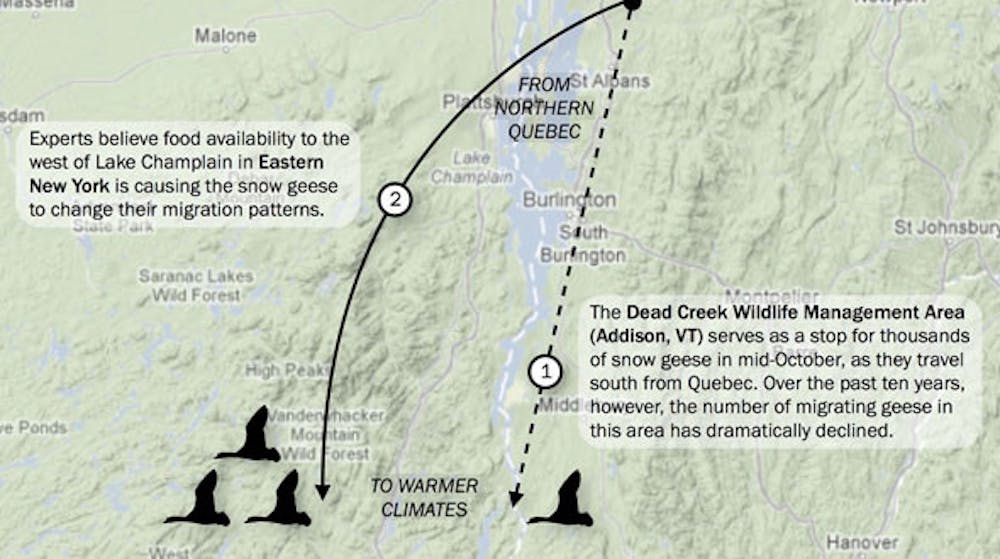The splendor of autumn in Vermont is always something to look forward to, especially in a small corner of Addison County where an annual fall visitor comes to roost.
Each fall around mid-October, thousands of strikingly white snow geese flock to Dead Creek, a wildlife management area in Addison County, to rest on their long journey south.
The Dead Creek habitat is characterized by its open stretches of water, cattail marshes and wooded areas. The uplands include farmland, open fields and forests. The state put in a series of dams and actively manages the water levels of flooded impoundments to preserve snow geese habitat.
Although their stay in Vermont is short, it does not go unobserved; hundreds of locals and visitors alike also flock to this area to photograph and observe these birds.
In the warmer months, snow geese rest and breed in northern climates on the Arctic tundra — in Greenland, Alaska, Canada and even the northeastern tip of Siberia. As the season changes, however, the birds take flight, following their familiar migratory path, which takes them southeast to the United States and Mexico.
The birds cover around 5,000 miles round trip. This distance is possible because of the efficient flying “V” formation — while in flight, each bird flies slightly above the bird behind it, creating uplift for its follower and reducing wind resistance. As the head goose, the bird flying at the point of the “V” gets tired, it drops back and rotates out of position, allowing for another bird to take its place.
According to scientists, this process affords geese the chance to travel greater distances than they would be able to alone.
With such a great distance to travel, snow geese can easily become fatigued or hungry and risk being left behind. Sanctuaries, such as the one provided at Dead Creek, give the birds a place to rest and rejuvenate on their journey.
Managed by the Vermont Fish and Wildlife department, Dead Creek Wildlife Management Area (WMA) is a 2,858-acre tract of land that spans Panton, Addison and Bridport. The Dead Creek WMA began as small parcels of land purchased from farmers, and, over time, has grown in size due to purchases financed by a Vermont state tax on firearms and ammunition.
A large portion of the Dead Creek WMA is regulated as a refuge, prohibiting public access. Snow geese rest among the trees and in the water in this area, out of hunters’ range.
Snow geese are not the only wildlife to be seen at the Dead Creek WMA — Canadian geese, other duck species and other waterfowl also inhabit the preserve. Regulated hunting and trapping is allowed, but only in controlled hunting areas. The season for hunting snow geese runs from Oct. 1 to Dec. 29.
The geese reach their peak number in mid to late October. The geese have numbered in excess of 5,000 in previous years and the annual population fluctuates because the population growth trend for snow geese is on rise.
Some observers are worried by the population increase. According to Cameron MacKugler ’09, New Haven resident and avid hunter, this trend could eventually lead to an abrupt decimation of the species, particularly in colder regions to the north of Vermont.
“There are more geese than there are grasses and the geese are grazing beneath the soil and consuming the plants’ roots as well, “ MacKugler said. “This is essentially destroying the tundra’s ability to regenerate ... and is leaving the land barren. State agencies monitoring hunting have expanded the daily limit of snow geese that a hunter may kill. While hunters may take 5 Canada geese, they may shoot 25 snow geese per day.”
Although the national population of snow geese is stable, fewer snow geese are flocking to Dead Creek now than in years past.
Professor of Environmental and Biosphere Studies Stephen Trombulak explained the recent change.
“Over the last few years snow geese have preferentially shifted their migratory route through the Champlain Valley over to the New York side of the lake,” he said.
Trombulak is not worried by the shifting migratory patterns.
“Plenty of geese still come through the area,” he said.
Observers continue to visit Dead Creek despite the declining number of geese. Often, observers hear the birds before they see them. Rising up from the cornstalks, massive flocks of the white birds will take to the air, drowning out all other sounds. Their bright white plumage accentuated by black-tipped wings contrasts with the fall foliage. Some grey snow geese, called “blue geese,” can be seen flying among their white counterparts at the close of their fleeting stay here in Vermont.
While many observers may miss this spectacle, vestiges of the snow geese are left behind — white feathers, floating atop the water or caught in the grass, offer a promise for next year’s return.
Snow Geese Population Booms, Migration Shifts

Comments



